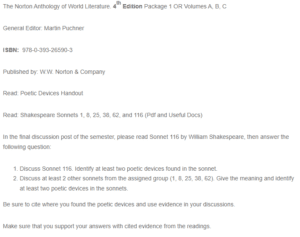Poetic Devices in the Sonnets
One of the poetic devices in Sonnet 116 is alliteration. Alliteration is concerned with word repetition that starts with identical constant sounds. In the first line, an example is “marriage” and “minds,” while in the fourth line, there are “remover” and “remove” (Skinner 185). Additionally, the speaker asserts love constancy, and as such, repetition has been used to strengthen his claims. For instance, he states, “Love is not love, which alters when it alteration finds” (Sonnet 116). The repetition of the key terms gives clarity to the speaker’s meaning. Furthermore, rhyming sounds have also been used in the poem. An example is present in the initial quatrain where the word finds rhymes with minds and is removed with love.
Further, Sonnet 62 talks about narcissism. Notably, the speaker thinks of himself as a young man and denounces his selfish pride. Nonetheless, even if he can intellectualize narcissism as a pitiful trait, he has it grounded in his heart. The poetic devices in the poem include imagery and alliteration. An instance of imagery in the poem is in the final lines, where the poet labels himself “Beat and chopped with tanned antiquity” (Shakespeare 62). In addition, alliteration is evident once terms are used in succession or rather are close and commence with similar sounds; for instance, my and my, as well as mine in the initial lines one and two. In line six, there is truth and truth.
In Sonnet 38, the poet compares the inconsiderately passionate youth and the affectionate, idealistic composer. Typically, the speaker seems piteously incapable of contemplating his life, lacking the youth, who is physically dissociated from the poet. The speaker’s emotional dependence on the young man takes over the poem. The utilized poetic devices are metaphor and alliteration. An example of alliteration is in the first line, “my muse,” and”n lines nine, the “tenth” and “ten times”. Met.”hor is evident in the third quatrain, where the poet states that youth is the tenth muse (Shakespeare 38).
Works Cited
Shakespeare, William. Sonnets, 1609. Payson & Clarke, 1968.
Skinner, Burrhus Frederic. “Alliteration in Shakespeare’s Sonnets: A Study in Liberary Behavior.” The Psychological Record 3 (1939): 185.
ORDER A PLAGIARISM-FREE PAPER HERE
We’ll write everything from scratch
Question

Poetic Devices in the Sonnets
The Norton Anthology of World Literature. 4th Edition Package 1 OR Volumes A, B, C
General Editor: Martin Puchner
ISBN: 978-0-393-26590-3
Published by: W.W. Norton & Company
Read: Poetic Devices Handout
Read: Shakespeare Sonnets 1, 8, 25, 38, 62, and 116 (Pdf and Useful Docs)
In the final discussion post of the semester, please read Sonnet 116 by William Shakespeare, then answer the following question:
- Discuss Sonnet 116. Identify at least two poetic devices found in the sonnet.
- Discuss at least two other sonnets from the assigned group (1, 8, 25, 38, 62). Give the meaning and identify at least two poetic devices in the sonnets.
Be sure to cite where you found the poetic devices and use evidence in your discussions.
Make sure that you support your answers with cited evidence from the readings.

